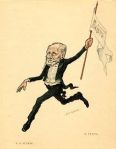Ballet mythologique in one act and three scenes
Music by Ludwig Minkus, Léo Delibes & Riccardo Drigo
World Première
30th January [O.S. 18th January] 1876
Imperial Bolshoi Kamenny Theatre, Saint Petersburg
Original 1876 Cast
Thetis, the Goddess of the Water
Eugenia Sokolova
Peleus
Pavel Gerdt
Cupid/Eros, the God of Love
Lyubov Savitskaya
Venus/Aphrodite, the Goddess of Love
Maria Gorshenkova
Jupiter/Zeus, King of the Gods
Christian Johansson
Adonis
Lev Ivanov
Triton
Platon Karsavin
Première of Petipa’s revival
9th August [O.S. 28th July] 1897
Olga Island, Peterhof Palace
Original 1897 Cast
Thetis, the Goddess of Water
Matilda Kschessinskaya
Peleus
Pavel Gerdt
Cupid/Eros, the God of Love
Olga Preobrazhenskaya
Venus/Aphrodite, the Goddess of Love
Olga Leonova
Flora, the Goddess of the Spring
Lyubov Roslavleva
Jupiter/Zeus, King of the Gods
Alexei Bulgakov
Adonis
Sergei Legat
Plot
Peleus, the son of King Aeacus of Aegina, accidentally wounds King Eurytion during a hunt. As he is dying, the King curses the young man, calling down the vengeance of the gods on his head. Spurned and persecuted, Peleus finds refuge with King Acastus, who orders the priests to ritually cleanse him of his sins. However, Acastus’s wife falls in love with Peleus and when he rejects her advances, she accuses him of trying to seduce her. Acastus commands that Peleus be chained to Mount Pelion for the wild beats to tear him apart, but Thetis, the elder daughter of the sea god Nereus, comes out of the water and saves Peleus. As a reward for his chastity, the gods grant him marriage to Thetis. The couple celebrate their wedding on Mount Olympus.

History
Les Aventures de Pélée (The Adventures of Peleus) is a mythological ballet created by Petipa and Ludwig Minkus based on the Greek myth of Peleus. The ballet was originally staged in three acts and five scenes and premiered at the Imperial Bolshoi Kamenny Theatre on the 30th January [O.S. 18th January] 1876. It included Bacchic and Infernal Dances, massed grouping in the Olympis scenes and dance passages La danse des Nereids and Les Transformations, in which Eugenia Sokolova, the original Thetis, distinguished herself with Pavel Gerdt as Peleus. Despite its use of very ordinary décor and costumes and Minkus’s music being found as colourless and unmelodious, the ballet was a success.
In 1897, the King of Siam and Kaiser Wilhelm II of Germany visited Russia and in their honour, a three-part gala was arranged and staged at Peterhof Palace from the 4th August [O.S. 23rd July]. For the second performance of the gala which was held in honour of Wilhelm II, Petipa revived Les Aventures de Pélée. In this revival, he completely transformed the ballet, reducing it from three acts and five scenes to one act and three scenes and staged it under a new title Les Noces de Thétis et Pélée (The Wedding of Thetis and Peleus). Riccardo Drigo revived Minkus’s score and composed new music additions. Music numbers by Léo Delibes were also added to the new revived score, which came from his incidental music to Victor Hugo’s Le Roi s’amuse.
Petipa’s revival of Les Noces de Thétis et Pélée premiered on the 9th August [O.S. 28th July] 1897 on Olga Island at Peterhof Palace with Matilda Kschessinskaya as Thetis and Pavel Gerdt as Peleus.
In her memoirs, Kschessinskaya gives the following account of the gala performance of Les Noces de Thétis et Pélée:
The second gala, the most brilliant of the three, was danced on July 28th in honour of the German Emperor, Wilhelm II, not at Peterhof Palace, but on Olga Island, in the middle of the upper lake. Stands for the spectators had been arranged all round on the island, itself, while the stage had been raised on piles above the water; the orchestra played in an enormous iron stand, below the level of the lake. The stage had only side scenery and wings: the magnificent view over the distant hills of Babigon served as a back-cloth. Not far from the stage was a little island, decorated with rocks and a grotto, in which I positioned myself at the very beginning of the performance. The programme for this gala was the one-act ballet ‘Thétis et Pélée’, arranged by Petipa to music by Delibes and Minkus. The guests reached the island in little boats. The whole scene was bathed in electric light and the ensemble had a fairy-like appearance. The ballet started with the opening of the grotto in which I was hidden: I then stepped out onto a mirror, which began to slide towards the stage. This gave the audience the impression that I was walking on the water. – Dancing in Petersburg: The Memoirs of Mathilde Kschessinska (p. 63-64)
Sources
- Letellier, Robert Ignatius (2008) The Ballets of Ludwig Minkus. Cambridge Scholars Publishing
- Kschessinskaya, Matilda, H.S.H. The Princess Romanovsky-Krassinsky (1960) Dancing in Petersburg: the Memoirs of Mathilde Kschessinskaya. Alton, Hampshire: Dance Books Ltd
